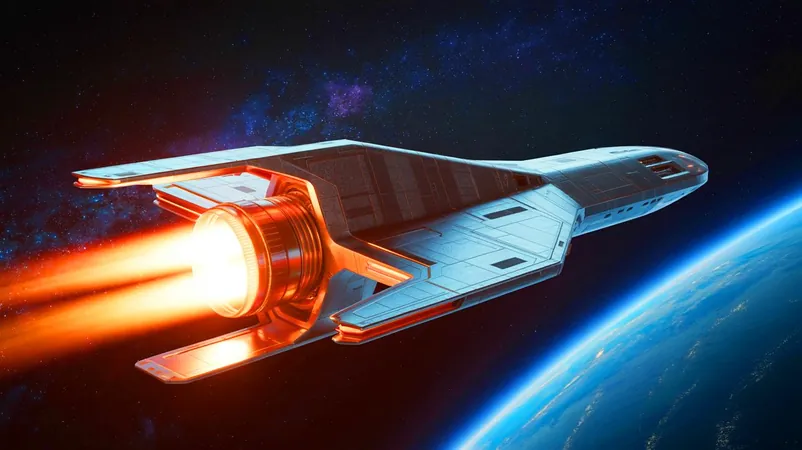
Revolutionary Liquid Uranium Rocket Could Slash Mars Travel Time to Just 6 Months!
2025-09-14
Author: Chun
A Game-Changer in Space Travel
Imagine embarking on a mission to Mars in just six months—a dream that could soon be a reality thanks to innovative research at The Ohio State University. Scientists are pioneering a cutting-edge propulsion system called the centrifugal nuclear thermal rocket (CNTR), which promises to transform how we explore our solar system. By harnessing the power of liquid uranium, this bold technology aims to significantly enhance rocket performance while minimizing operational risks.
Speeding Through the Cosmos
The limitations of traditional chemical rockets have long restricted our ability to conduct long-distance space missions. These engines, notorious for their low thrust and high fuel consumption, lead to lengthy and expensive journeys. The New Horizons probe, for instance, took nine years to reach Pluto—an experience that underscores the urgent need for advanced propulsion technologies. With the CNTR's projected specific impulse soaring to 1,800 seconds, compared to the 450 seconds of chemical engines, the future looks promising for faster travel to Mars and beyond.
A Vision for Future Explorations
Spencer Christian, a PhD student spearheading the CNTR prototype, envisions a safe, swift one-way trip to Mars in just six months. This remarkable reduction in travel time not only enhances human exploration prospects but also lowers health risks associated with extended space outings. The CNTR’s potential isn’t limited to Mars; it opens the door for rapid scientific missions to outer planets and even mysterious Kuiper Belt objects.
Tackling Engineering Challenges
While the CNTR technology is groundbreaking, it comes with its share of engineering hurdles. Ensuring stable startup, smooth operation, and reliable shutdown, along with minimizing uranium fuel loss and managing engine failures, are critical challenges the Ohio State team faces. Project leader Dean Wang remains optimistic that these issues can be resolved in the next five years.
Versatile Propulsion Solutions
One of the most exciting features of nuclear thermal propulsion is its adaptability. The CNTR can utilize various propellants, including ammonia, methane, propane, or hydrazine, allowing for mission-specific fuel selection. This versatility could enable us to exploit in-space resources from asteroids and Kuiper Belt objects, paving the way for a more self-sustaining presence in space.
Boosting Our Space Exploration Endeavors
The Ohio State team’s trailblazing efforts are supported by a NASA grant, highlighting the national significance of nuclear propulsion advancements. This collaboration shows a united commitment from academia and government to tackle the obstacles of deep-space exploration, solidifying the United States’ position at the forefront of the upcoming era of space travel.
Future Impact on Human Space Exploration
The implications of CNTR technology extend far beyond its initial capabilities. Quicker and more efficient travel could open up exciting new pathways for scientific research that were previously deemed impractical. Moreover, the ability to maintain a self-sustaining presence in space could lead to permanent bases on celestial bodies, representing a monumental leap in humanity's journey toward becoming a multi-planetary species.
A Promising Horizon
As researchers at The Ohio State University push the boundaries of propulsion technology, the question looms: How will these advancements redefine human exploration in the cosmos? The quest for answers promises to be as thrilling and transformative as the destinations themselves—ushering in a future where space travel is not only faster but also safer and more accessible.



 Brasil (PT)
Brasil (PT)
 Canada (EN)
Canada (EN)
 Chile (ES)
Chile (ES)
 Česko (CS)
Česko (CS)
 대한민국 (KO)
대한민국 (KO)
 España (ES)
España (ES)
 France (FR)
France (FR)
 Hong Kong (EN)
Hong Kong (EN)
 Italia (IT)
Italia (IT)
 日本 (JA)
日本 (JA)
 Magyarország (HU)
Magyarország (HU)
 Norge (NO)
Norge (NO)
 Polska (PL)
Polska (PL)
 Schweiz (DE)
Schweiz (DE)
 Singapore (EN)
Singapore (EN)
 Sverige (SV)
Sverige (SV)
 Suomi (FI)
Suomi (FI)
 Türkiye (TR)
Türkiye (TR)
 الإمارات العربية المتحدة (AR)
الإمارات العربية المتحدة (AR)